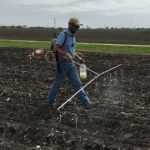Much of the 2017 corn crop has been planted. As we see farmers begin to plant their sorghum or soybeans, we need to make sure not to forget insect and weed management in these young corn fields.
Much of the insect control on corn in South Texas is done by planting Bt corn hybrids treated with insecticides for control of early season insect pests. However, it is still a good practice to visit these fields on a weekly basis to check for potential insect pests.

Chinch Bugs http://agrilife.org/sorghumipm/insect-pests/chinchbugs/
While corn needs to be checked for chinch bugs, I do not expect to see them in damaging numbers. This pest tends to me more problematic in dry conditions.
Chinch bugs can be a pest of seedling corn until it reaches a height of 12 inches. Application to control chinch bugs is rarely necessary if insecticidal seed treatments are used.
Insecticide should be applied when two or more adult chinch bugs are found on 20 percent of the seedlings less than 6 inches high. On taller plants apply insecticides when immature and adult bugs are found on 75 percent of the plants. For the application to be successful, use very high water volume (30 GPA) and multiple nozzles per row, directed at the plants.
Weeds are a pest of primary focus at and shortly after planting. Right now, many fields have high numbers of newly emerged seedling grass and broadleaf weeds. Controlling these weeds before they reach a height of 4-6 inches is important as larger weeds are much more difficult to control.
This morning, Dr. Josh McGinty made applications to a herbicide trial targeting control of smellmelon. This trial will have subsequent applications in a few weeks. The treatments evaluated are both pre- and post-emergent herbicides.
trial targeting control of smellmelon. This trial will have subsequent applications in a few weeks. The treatments evaluated are both pre- and post-emergent herbicides.
More information will be coming in the next month concerning this trial.